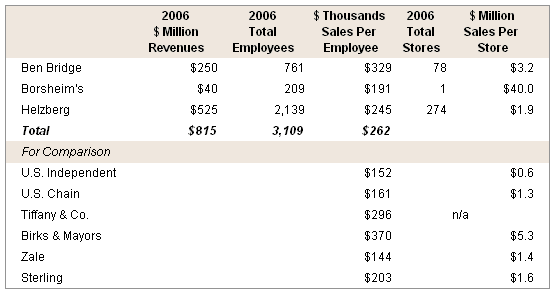IDEX Online Research: A Very Savvy Investor Validates Jewelry Industry Future
June 12, 07
If we were going to ask someone to validate the future of the jewelry industry, we’d be hard-pressed to think of anyone better than Warren Buffett, the brains and brawn behind the highly successful Berkshire Hathaway investment company.
Buffett caused Wall Street to sit up and take notice when he purchased retail jewelers Borsheim’s Jewelry, Helzberg Diamond Shops and Ben Bridge Jeweler. Now, he has taken one step back into the pipeline with his recent purchase of Aurafin and Bel-Oro, both major gold jewelry suppliers.
Buffett’s three jewelry retail holdings, with revenues of $815 million in 2006, coupled with the acquisition of Aurafin and Bel-Oro, with estimated combined revenues in the $400-450 million range, will generate just over $1.2 billion in revenues for Berkshire Hathaway from the jewelry industry, or 1.2 percent of its 2006 corporate revenues of $98.5 billion.
What’s Going On?
The jewelry industry is not on most investors’ lists of “Most Favored Industries”. Outsiders, including venture capital funds, private equity groups, and Wall Street analysts have difficulty understanding the industry. From a high level, its financials are not compelling. It is a closed industry, “veiled in secrecy”, as Lazare Kaplan chairman Maurice Tempelsman described it a few years ago.
It is difficult to put Buffett’s investment philosophy in a few words – many try, few succeed – but our view is that he looks for three key factors: 1) under-valued industries and companies with solid long term potential; 2) great management; and 3) the ability to leverage a modest investment.
Assuming these factors are key to his investment yardstick, it is clear why he chose to invest in Borsheim’s, Ben Bridge, and Helzberg. It is also clear why he chose to acquire Bel-Oro and Aurafin. All have excellent management teams, all are in an undervalued industry, and all have the ability to return substantial profits on a modest capital base.
Buffett gets hundreds of offers from companies wanting to sell out. If you read his annual report – which is written in a down-to-earth folksy style – you know that most of his ideas come from his internal team or from management of companies he already owns. In short, it is difficult to get his attention, unless you have an inside track. Further, Buffett is patient: he acquired Helzberg in 1995 and Ben Bridge in 2000.
Putting the Bel-Oro & Aurafin Acquisitions in Perspective
Currently, Warren Buffett’s investment company, Berkshire Hathaway, has only modest exposure to the jewelry industry. Last year, the company’s three retail jewelry holdings generated revenues of $815 million, or 0.8 percent (less than 1 percent) of the company’s $98.5 billion in revenues. Here’s what generates Berkshire Hathaway’s revenues:
Berkshire Hathaway Businesses Companies What they do
Source: Berkshire Hathaway Group Insurance GEICO, General Re Berkshire Hathaway Reinsurance Group Berkshire Hathaway Primary Group Underwriting insurance, reinsurance Finance BH Finance, Clayton Homes XTRA, CORT, other Investing, consumer finance, transportation leasing, furniture leasing, life annuities McLane McLane Company Wholesale distribution of groceries & non-food items Midamerican MidAmerican Regulated electric & gas utility; domestic real estate brokerage Shaw Shaw Industries Manufacturing of carpet and floor coverings Other Manufacturing: Manufacturing Acme Building Brands Benjamin Moore H.H. Brown Shoe CTB Fechheimer Brothers Forest River Fruit of the Loom Garan ISCAR Johns Manville Justin Brands Larson-Juhl MiTek Russell Scott Fetzer Service: Service Buffalo News Business Wire FlightSafety International Dairy Queen Pampered Chef NetJets Retailing: Retail Ben Bridge Jeweler Borsheim's Helzberg Diamond Shops Jordan's Furniture Nebraska Furniture Mart See's Star Furniture R.C. Willey
The following table summarizes revenues by major operating division for Berkshire Hathaway in 2006.
Berkshire Hathaway $ Billions Percent
2006 Revenues
Source: Berkshire Hathaway Group
Revenues
of Total Insurance $28.3 29% Finance $5.1 5% McLane $25.7 26% MidAmerican $10.6 11% Shaw $5.8 6% Other $21.1 21% Manufacturing $12.0 Service $5.8 Retail $3.3 Other Misc $1.8 2% Total $98.5 100%
Assuming that the combined revenues of Bel-Oro and Aurafin are in the $400-450 million range, they will barely be a blip on Buffett’s radar screen. In total, they will represent less than one-half of one percent of Berkshire Hathaway’s annual revenues.
Combined annual revenues from all jewelry-related businesses will be an estimated $1.2 billion, or just over 1 percent of total Berkshire Hathaway corporate revenues, when the acquisitions are assimilated.
Jewelry Was Not a Stellar Performer in 2006 for Berkshire Hathaway
During 2006, Berkshire Hathaway generated $815 million from its three jewelry retail holdings, up a very modest 1.7 percent from the prior year. That compares to total industry growth of 7.1 percent.
The following tables summarize revenue levels and growth in the company’s retail jewelry holdings. The revenue figures come from three sources: National Jeweler’s annual State of the Industry summary (“Supersellers”), Berkshire Hathaway legal filings and math “plugs”.
The math plug is for Borsheim’s, based on National Jeweler’s sales estimates for Ben Bridge and Helzberg. The table indicates that Borsheim’s revenues have declined for the past three years. We consider this unlikely. Historically, we have estimated that Borsheim’s annual revenues are in the $50 million range. We believe that National Jeweler’s rounding of revenues for the other two jewelers – Ben Bridge and Helzberg – may have distorted Borsheim’s actual sales.
Retail Jewelry Sales by Division
Berkshire Hathaway
Source: Berkshire Hathaway $ Millions 2004 2005 2006 Source Ben Bridge $200 $230 $250 National Jeweler Borsheim's $58 $51 $40 Math "plug" Helzberg $500 $520 $525 National Jeweler $758 $801 $815 Berkshire Hathaway
The following table summarizes the estimated annual total revenue change, year-to-year, for the individual jewelry retailing operations owned by Berkshire Hathaway, based on estimated revenues from various sources.
Total Sales Change 2005 2006
% Chg Y/Y Ben Bridge 15% 9% Borsheim's -12% -22% Helzberg 4% 1%
The following table summarizes same-store sales changes for the individual jewelry retailing operations owned by Berkshire Hathaway. The company disclosed these results in its legal filings.
Same-Store Sales Change 2004 2005 2006 11.4% 6.6% n/a n/a n/a n/a n/a n/a n/a
% Chg Y/Y Ben Bridge Borsheim's Helzberg
The following table summarizes employment levels for each of the individual jewelry retailing operations owned by Berkshire Hathaway.
| Retail Jewelry Employees by Division
|
The following table summarizes changes in employment levels for each of the individual jewelry retailing operations owned by Berkshire Hathaway.
2005 2006
Employees - Percent Change
% Chg Y/Y Ben Bridge 0.1% 2.8% Borsheim's -5.8% -7.5% Helzberg -8.3% -9.9%
Buffett’s Jewelry Holdings Generate Solid Productivity
Assuming that the sales estimates are reasonable (we would not have used them, if we believed otherwise), key productivity measures for the jewelry retailers in Berkshire Hathaway’s portfolio are well above the industry averages. For example, their sales per employee is $262,000; that’s well above Sterling (which includes Jared) and is nipping at the heels of powerhouse Tiffany.
Ben Bridge is clearly the top performer, with sales per employee of $329,000. Bridge’s sales per store are also stellar. Not only are average store sales of $3.2 million well above almost all of the jewelers on the list below, they are also well above the average for a typical AGS store of $2.4 million.
| Berkshire Hathaway Retail Jewelry Holdings |
Buffett Highlights Jewelry Holdings in Annual Report
In Berkshire Hathaway annual reports, Buffett has spotlighted his jewelry industry holdings generally when things look good, but not always:
- 2006 Annual Report – Minimal discussion of the jewelry business. Total jewelry sales for Berkshire Hathaway were up a weak 1.7 percent versus an industry sales gain of 7.1 percent. Further, as a group, specialty jewelers in America posted a sales gain of 6.4 percent in 2006.
- 2005 Annual Report – “I told you last year that Ben Bridge (jewelry) . . . had same-store sales gains far above the average of their industries. You might think that blow-out figures in one year would make comparisons difficult the following year. But Ed and Jon Bridge at their operation . . . were more than up to this challenge. Ben Bridge had a 6.6 percent same-store gain in 2005 . . . .”
“Borsheim’s operates on a gross margin that . . . is fully twenty percentage points below that of its top rivals.” - 2004 Annual Report – “At Ben Bridge, same-store sales grew 11.4 percent, the best gain among the publicly-held jewelers whose reports I have seen. Additionally, the company’s profit margin widened. Last year was not a fluke: during the past decade, the same-store sales gains of the company have averaged 8.8 percent.
“Ed and John Bridge are fourth-generation managers and run the business exactly as if it were their own – which it is in every respect except for Berkshire’s name on the stock certificates. The Bridges have expanded successfully by securing the right locations and, more importantly, by staffing these stores with enthusiastic and knowledgeable associates.” - 2002 & 2003 Annual Reports – Minimal discussion on the jewelry business.
- 2001 Annual Report – “In jewelry, same-store sales fell by 7.6 percent, and pre-tax margins were 8.9 percent versus 10.7 percent in 2000. Return on invested capital remains high.” Editor’s note: the typical independent specialty jeweler in America earned a 4.0 percent pre-tax profit in 2005; Zale earned a 2.9 percent pre-tax profit last year; and, Signet Group earned a pre-tax profit of 11.3 percent in 2006.
“Borsheim’s – the largest jewelry store in the country except for Tiffany’s Manhattan store – will have two shareholder-only events. Shareholder prices will be available . . . . Borsheim’s operates on a gross margin that is fully twenty percentage points below that of its major rivals, so the more you buy, the more you save (or at least that’s what my wife and daughter tell me). Come by and let us perform a walletectomy on you.”
What Happens Next?
Frankly, we were surprised that Buffett made an investment in jewelry suppliers. Traditionally, the profits are made at each end of the pipeline – mining and retail – with little profitability in the middle of the distribution pipeline. However, the financial return on capital invested can be handsome, if properly positioned and understood. Most banks don’t understand the returns, and Wall Street is still generally in the dark.
It would not surprise us to see Buffett take a position at the production end of the pipeline, provided he can find value. If he were to acquire a gold mining company, he would have exposure from mine to market. Over the long term, gold has proven to be a solid store of value and a vehicle for price appreciation.
As global investors move out of the holdings of U.S. dollars (the future of the dollar looks a bit bleak), they will seek new holdings. The Euro holds promise, as does the Yen and the Yuan. But, in the meantime, parking their money in gold just might yield an above-average return.
